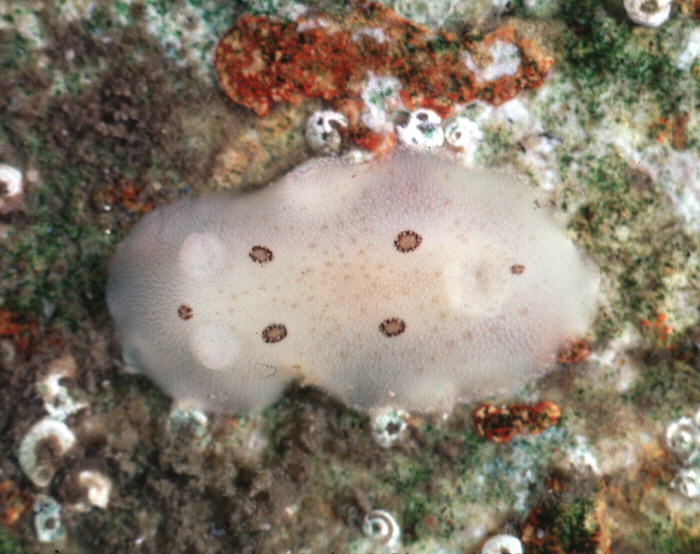 |
Diaulula sandiegensis
Photo courtesy of Dave Behrens
Diaulula sandiegensis (Cooper, 1863)
The Doris s.l. species dilemma solved. Another case of Mistaken Identity.
Diaulula sandiegensis (Cooper, 1863) (=Doris s.l. species; and Doris
odonoghuei)
For some time I have thought that the California dorid nudibranch referred to as Doris s.l. species (photo of typical specimen shown above) was a valid and distinct species and should receive proper designation. Doris s.l. species was originally introduced in Studies of the Opisthobranchiate Mollusks of the Pacific Coast of North America by Frank Mace MacFarland which was published posthumously in 1966. Referred to since as "MacFarland's Memoirs", it is comprised of a series of unpublished notes Dr. MacFarland was preparing, at the time of his death. One of several of the undescribed species included was referred to as Doris (s.l.), species. MacFarland frequently used Latin abbreviations in his notes and manuscripts, and in this instance "s.l." of course, referred to the Latin, sensu lato, or "in the greater sense." In the Memoirs, this species was not proposed as a specum novum, nor was a holotype designated. The International Code of Zoological Nomenclature (ICZN, 1999) requires that the specific name consist of one word only and prohibits the use of single letters for species-group names. The use of the word "species" as a specific name, although not denied by the Code, was in my opinion inappropriate. The name Doris (s.l.) species MacFarland (1996) has been carried in the literature in numerous publications even though nomenclaturally incorrect by ICZN rules.
Angel Valdes and I have just completed a study comparing the internal anatomy of specimens with the identical features of the specimen shown above, with variations of Diaulula sandiegensis (Cooper, 1863). In a "nut shell" what we found is that the internal features of Doris (s.l.) species, including reproductive system and radular characteristics, fit perfectly those of Diaulula sandiegensis, described much earlier.
Externally the variation in the ground color of the notum in Diaulula sandiegensis (white to pale yellow) and the degree dorsal spotting (from a very few donut shaped spots to hundreds of smaller spots , encompass that of Doris (s.l.). The caryophylidia (spiculose tubercles) are identical in the two species.
While preparing our manuscript, another species emerged, adding mystery to the dilemma. Prior to the publication of MacFarland's Memoirs, a species with similar external characteristics was described as Doris echinata O'Donoghue (1922). See if you can follow this trail of nomenclatural history. Iredale & O'Donoghue (1923) reassigned this species to Doridigitata d'Orbidny, 1839, and changed the name (without explanation) to Doridigitata macualta. Steinberg (1963) recognized that both the O'Donoghue names were preoccupied by Doris echinata Loven 1846 and Doris maculata Garstang 1896, respectively, and proposed a new name, Doris odonoghuei for this species. In this paper she questions it's accurate placement in Doris and suggests further study. The O'Donoghue (1922) description of Doris echinata was brief, and there was no description of the reproductive system. O'Donoghue stated that though he felt that the classification of the family was unsatisfactory, D. echinata fell within the definition. Steinberg (1963) in proposing the name Doris o'donoghuei to rectify the preoccupancy issue of the names, discussed earlier, examined two specimens from the collection of the Friday Harbor Marine Laboratories. Questioning the assignment of the species to Doris, she dissected the smaller of the two but came to no satisfactory conclusion. Since that time no published accounts or casual observations have been made of this species. Dr. Sandra Millen tells us that she had never collected specimens, in the Vancouver, British Columbia area, she could clearly identify as D. odonoghuei, finding it impossible to distinguish it from small Diaulula sandiegensis.
Whereas this species has not been definitely confirmed since O'Donoghue's description and no type material is available for examination, and whereas this description cannot be differentiated from Diaulula sandiegensis, Angel and I suggest that this species is specum dubum.
Now you might ask - What does all this polynomial, Anglo-Saxon derivative
mumbo jumbo mean? Well it means go to your copy of Pacific Coast
Nudibranchs , and on the top of page 67 cross out "Diaulula sp. 1" (aka
Doris s.l.) and write in Diaulala sandiegensis - Doris s.l. is no more.
And at the next cocktail party when someone asks you about the status of
D. odonoghuei, just tell them - "it's out of here."
References:
BEHRENS, DAVID W. 1980. Pacific coast nudibranchs: a guide to the
opisthobranchs of the northeastern Pacific. Second edition. Sea
Challengers, Monterey, CA. 107p.
BEHRENS, DAVID W. and ANGEL VALDES. 2001. The identity of Doris (s.l.)
species MacFarland, 1966 (Mollusca, Nudibranchia, Discodorididae): A
persistent mystery from California solved. Proceedings of the California
Academy of Sciences: 52(15): 183-193.
MACFARLAND, FRANK MACE. 1966. Studies of the Opisthobranchiate Mollusks
of the Pacific coast of North America. Memoirs of the California Academy
of Sciences. Vol. 6. San Francisco.
Danville, CA
Sep. 2001
Taxonomic information courtesy of Dave Behrens

David W. Behrens
Author:
Pacific Coast Nudibranchs |
